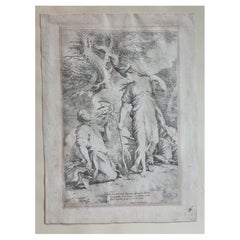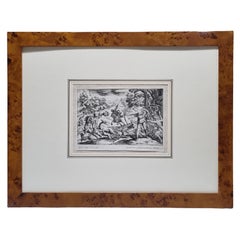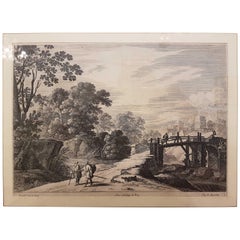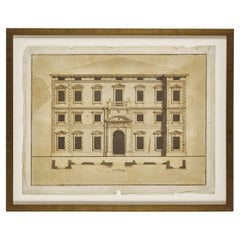Bellezza Antiquity Wall Decorations
11
to
5
11
11
11
11
6
11
Height
to
Width
to
11
3
3
11
4
3
2
2
2
2
1
1
1
17th Century Etchingn "Adoration of the Magi" by Pietro Testa, circa 1640
By Pietro Testa
Located in Cagliari, IT
Beautiful etching representing the classic religious subject of the "Adoration of the Magi" by the Baroque painter and engraver Pietro Testa known as il Lucchesino.
The print derives from an oil on canvas of the same name now in Montpelier.
Identified by the TPL monogram on the right and the dedication signature.
Paolo Bellini in the book "L'opera incisa di Pietro Testa" (The engraving work of Pietro Testa) ,published in 1976 by Neri Pozza in Vicenza, identifies this work as an example of the third state of three since, respect to the second state, the address of Gio Giacomo Rossi is added .
In the lower margin there is the dedication in Latin to:
Most illustrious and most reverend (cardinal) Gerolamo Bonvisi, Cleric of the Apostolic Chamber, D.D.
The star on the left often blushes with the light of evil / Kings live here so that they recognize the Lord, / happy face good star shines benignly./ Petrus Testa
Pietro Testa (1611–1650) was an Italian High Baroque artist active in Rome. He is best known as a printmaker and draftsman.
He was born in Lucca, and thus is sometimes called il Lucchesino. He moved to Rome early in life. One source states he was ejected from the Cortona studio in 1631, soon after joining the workshop. Others state Testa trained under Pietro Paolini or under Domenichino, for whom he worked under the patronage of Cassiano dal Pozzo. He was friends with Nicolas Poussin and Francesco Mola.
Some of his etchings, which often include work in drypoint, have a fantastic quality reminiscent of Jacques Callot, or embellishments of his Genoese contemporary Giovanni Benedetto Castiglione and even presciently suggest William Blake. His Sacrifice of Iphigenia appears to have influenced Tiepolo's rendition at Villa Valmarana Ai Nani in Vicenza. His early prints, from the 1630s, were often religious and were influenced by Federico Barocci...
Category
Antique 17th Century Italian Baroque Prints
Materials
Paper
17th Century Etchingn and Drypoint" Ceres and Phytalus" by Salvator Rosa, 1662
By Salvator Rosa
Located in Cagliari, IT
" Ceres and Phytalus"
To left, Phytalus, kneeling, receives the fig tree from the goddess Ceres, standing to right, as a reward for his hospitality. Etching and drypoint, circa 1662...
Category
Antique 17th Century Italian Baroque Prints
Materials
Paper
17th Century "Diana's Deer and Boar Hunt" Etching by Antonio Tempesta
By Antonio Tempesta
Located in Cagliari, IT
A fine mythological etching by the great Italian engraver Antonio Tempesta (Florence, 1555 – Rome, 5 August 1630) printed by François L'Anglois or Langlois (12 May 1589 (baptised) – 13 January 1647),also called F. L. D. Ciartres (" Francois Langlois from Chartres"). Beautiful sheet , very sharp .
The dimensions below are inclusive of the frame, the print without the frame measures 27x19 cm
Antonio Tempesta, also called il Tempestino (1555 – 5 August 1630), was an Italian painter and engraver, whose art acted as a point of connection between Baroque Rome and the culture of Antwerp. Much of his work depicts major battles and historical figures.
He was born and trained in Florence and painted in a variety of styles, influenced to some degree by "Counter-Maniera" or Counter-Mannerism. He enrolled in the Florentine Accademia delle Arti del Disegno in 1576. He was a pupil of Santi di Tito, then of the Flemish painter Joannes Stradanus. He was part of the large team of artists working under Giorgio Vasari on the interior decoration of the Palazzo Vecchio in Florence.
His favourite subjects were battles, cavalcades, and processions. He relocated to Rome, where he associated with artists from the Habsburg Netherlands, which may have led to his facility with landscape painting.
Among his followers was Marzio di Colantonio.
Tempesta and the Flemish painter Matthijs Bril were commissioned by Pope Gregory XIII to paint wide panoramas of the Procession to Transfer the Relics of St. Gregory of Nazianzus (1572) for the loggias on the third floor of the Vatican Palace. He completed frescoes in the Palazzina Gambara at the Villa Lante in Bagnaia (1578-1609). From 1579–83, Tempesta participated in the decoration of the Villa Farnese in Caprarola, notably of this villa's Scala Regia. He is also known to have collaborated on frescoes in the Villa d'Este at Tivoli and the Palazzina Gamara at Villa Lante, Bagnaia. He painted a series of turbulent and crowded battle scenes for the Medici. He also completed a series of engravings on outdoor courtly hunting scenes.
Tempesta painted frescoes for the Palazzos Colonna, the Doria Pamphilj, and for the Marchese Giustiniani in his Roman palace, where Tempesta collaborated with Paul Bril, and at Bassano di Sutri. He painted a Massacre of the Innocents for the church of Santo Stefano Rotondo in Rome.
Tempesta is now best known as a printmaker in etching and engraving. He also left numerous etchings, among them: Plates from the Old Testament; twenty-four plates from the Life of St. Anthony; a set of 150 prints from Ovid’s Metamorphoses; 13 plates on The Labours of Hercules and four plates on respectively The ages of man; The entry of Alexander into Babylon; Diana and Actaon, and The crucifixion (1612).
In 1612 he engraved a series of plates under the title "Batavorum cum Romanis Bellum" after designs of the Netherlandish artist Otto van Veen, also known as Vaenius (1556-1629) and court painter to Alessandro Farnese. Van Veen was influenced by the Italian mannerists but had developed his own style anticipating the Flemish baroque of his pupil Peter Paul Rubens. The series consists of 36 numbered engraved plates and illustrates the armed struggle between the ancient Dutch tribes and their Roman oppressors as narrated in Tacitus' Histories. Each plate bears at the bottom an engraved legend in Flemish and in Latin while a detailed explanation is printed on the otherwise blank verso. Plate I, signed 'Ant.Tempesta f. Anno 1611', shows 'Roma' and 'Batavia' in battle dress with respective scenic backgrounds, symbolizing the two nations. Fifteen other plates bear Tempesta's monogram. The plates depict heroic events, sieges, and battle scenes. This historicist work was very popular in its time.
Tempesta also drew many designs for tapestries.
François L’Anglois or Langlois (12 May 1589 (baptised) – 13 January 1647), also called F. L. D. Ciartres ("François Langlois from Chartres"), was a French print publisher, print seller, engraver, bookseller, art dealer, and painter. He is widely considered to have been the first important print publisher in France and to have contributed significantly to spreading awareness of contemporary artists' work throughout Europe.
François L’Anglois was born in Chartres and baptised there on 12 May 1589. He visited Italy on several occasions: Rome in 1613 and 1614 and Genoa, Florence, and Rome again in 1621. On these trips he met Anthony van Dyck and Claude Vignon, who both painted his portrait. He also became acquainted with the engravers Stefano della Bella and François Collignon. It was probably around this time that he acquired the nickname of Chartres (Ciartres in Italian). In 1624–1625 he was associated with Vignon as an art dealer (paintings) and acted as a print collector for Thomas Howard, 14th Earl of Arundel, and Charles I of England...
Category
Antique 17th Century French Baroque Prints
Materials
Paper
17th Century Pair of Burin Prints by Giovanni Battista Vanni, Italy, 1642
By Giovanni Battista Vanni, Antonio da Correggio
Located in Cagliari, IT
A beautiful pair of burin engravings depicting "Saint Bernardo degli Uberti" and "Saint Hilary of Poitiers" two of the patron saints of the city included in the base of the cupola ( dome ) of Parma cathedral frescoed by Antonio Allegri known as Correggio (Correggio, August 1489-Correggio 5 March 1534) between 1524 and 1530. Admirable work by the great master in which his genius as a forerunner of the Baroque is fully seen.
In 1642 Giovanni Battista Vanni etched a series of fifteen plates from Correggio's frescoes.
Giovanni Battista Vanni was born in Pisa around 1599; he studied successively under Jacopo da Empoli, Aurelio Lomi, and Matteo Rosselli, and then became a disciple of Cristofano Allori. He is better known as an engraver than as a painter. From 1624 to 1632, he lived in Rome, then returning to Florence after visiting Venice.
In addition to the series of prints...
Category
Antique 17th Century Italian Baroque Prints
Materials
Paper
17th Century Pair of Etchings by Theodoor Van Thunlden from Rubens, Antwerp 1642
By Peter Paul Rubens, Theodoor van Thulden
Located in Cagliari, IT
"Arch dedicated to Hercules" and "Arch dedicated to Bellerophon"
Splendid and very rare etchings belonging to a suite of subjects executed for the preparations of the "Celebrations for the entry into Antwerp of the Cardinal-Infante Ferdinando of Habsburg-Spain on 17 April 1635".
The sketches for the decorations were all drawn by Sir Peter Paul Rubens and the execution of the etchings was entrusted to Van Thulden.
Bottom left: P.P. Rubens. Bottom right: G. Gervatius (who was commissioned to bring together the illustrations of the arches in a special volume) and Van Thulden.
Laid paper with watermark - copper imprint - margins - excellent condition.
At the end of 1634 Peter Paul Rubens (1577-1640) was invited to make a series of drawings to decorate the city of Antwerp on the occasion of the solemn entry of the infant cardinal Ferdinand of Habsburg (1609-1641) who, after his death of Archduchess Isabella Clara Eugenia (1633), Spanish governor of the southern Netherlands, had been elected as his successor. Generally in these circumstances, the itinerary was articulated through a series of stations and the city - in its main urban hubs - was adorned with decorations and ephemeral apparatuses which, without solution of continuity, covered the facades of the palaces, churches and convents facing the parade axis of the celebratory itinerary, testifying to the participatory role of the various public and private institutions that took part in the feast1. As had happened for the entrances of Charles V in 1520, of Philip II in 1549 and of the archdukes Albert and Isabella in 1599, also in this case, on 17 April 1635, the most important streets and squares of Antwerp were enriched with arrangements: temporary altars, four scenarios, a portico and large triumphal arches built in wood, over twenty meters height, decorated with paintings, sculptures and allegorical scenes. The references to the ancient alluded in this case to the greatness of the Habsburgs and to the merits of Ferdinand for the victory obtained over the Protestant armies of Sweden and their German allies. The choice to use the triumphal arch has its roots in the "city of the popes" and must be read as a connection with the triumphal and modern arches, with Rome and with the "possession" ceremony, placing the emphasis on its centuries-old use . In the elaboration of the drawings and sketches Rubens proved to be a true connoisseur of architecture, but what is most surprising about the artist is the casual use of architectural language and fidelity to sixteenth-century Roman models. In order for the memory of these works to be perpetuated over time, some artists were commissioned to etch the ephemeral apparatuses and, under the guidance of the painter Theodor van Thulden...
Category
Antique 17th Century Belgian Baroque Prints
Materials
Paper
17th Century Gabriel Perelle "Landscape" Etching, France, circa 1660
By Gabriel Perelle
Located in Cagliari, IT
A French landscape by Gabriel Perelle. With a modern walnut frame
Gabriel Perelle (Vernon, 1604 - Paris, 1677) was a French engraver, draftsman and printer of topographic views and landscapes.
A pupil of Simon Vouet, Perelle specialized in landscapes with a classical setting, not unlike those of Francisque Millet, although with clearly decorative pretensions. He founded an etching lab, with the collaboration of his sons Nicolas and Adam.
Perelle was also a pupil of Daniel Rabel and produced hundreds of engravings from his drawings, as well as compositions by fellow antagonists such as Israël Silvestre, Paul Bril, Jacques Callot, Michel Corneille the Elder, Jan Asselijn...
Category
Antique 1660s French Baroque Prints
Materials
Paper
16th Century Hieronimus Cock, Pair of Burin from "The Story of Jonas"
By Hieronymus Cock
Located in Cagliari, IT
Beautiful pair of prints from the series "The Story of Jonas" including "The departure of Jonas" and "Jonas and the whale". Printed by Hieronimus Cock on a drawing by Hans Bol (1554-1593).
Hieronimus Cock (Antwerp 1507-1590) was a painter, engraver and print merchant. He was a master and editor of Pieter Bruegel...
Category
Antique 16th Century Belgian Prints
Materials
Copper
17th Century Francesco Curti "Vendor of Shoes" Etching
By Giuseppe Maria Mitelli, Francesco Curti
Located in Cagliari, IT
The print is part of the series consisting of forty engravings, "I mestieri per la via" (The crafts on the road), engraved by Francesco Curti (Bologna ca.1603- Bologna 1670) by an in...
Category
Antique 1660s Italian Prints
Materials
Copper
17th Century Flaemish Abraham Genoels II "Landscape with Rabbit" Etching
By Abraham Genoels II
Located in Cagliari, IT
Beautiful etching by Abraham Genoels II (Antwerp 1640-1723) from a painting by Adam Frans van der Meulen (Brussels 1844-Paris 1690).
Excellent state of conservation with wide margin...
Category
Antique Late 17th Century Belgian Prints
Materials
Copper
17th Century Jan Van De Velde Print "January" from the Months, 1618
By Jan Van de Velde, Claes Jansz. Visscher (II)
Located in Cagliari, IT
Beautiful burin from the rare suite "The Months" performed by the artist and engraved by Claens Jansz Visscher (1587-19 June 1652).
Very fresh and well contrasted, laid paper with w...
Category
Antique 1610s Dutch Prints
Materials
Paper
17th Century Jan Van De Velde Print "October" from the Months, 1618
By Claes Jansz. Visscher (II), Jan Van de Velde
Located in Cagliari, IT
Beautiful burin from the rare suite "The Months" performed by the artist and engraved by Claens Jansz Visscher (1587-19 June 1652).
Very fresh and well contrasted, laid paper with w...
Category
Antique 1610s Dutch Prints
Materials
Paper
Related Items
17th Century Pen and Ink Architectural Drawing Signed Bartolomeo Pedrelli
Located in New York, NY
17th Century Italian Architectural Drawing of a Palazzo which has been done with pen and ink with a grey wash. Signed on reverse by Bart...
Category
Antique 17th Century Italian Neoclassical Decorative Art
Materials
Paper
H 24 in W 29.75 in D 1.5 in
Original Antique Print After Rubens, Jesus Christ Descent from the Cross, C.1850
By Peter Paul Rubens
Located in St Annes, Lancashire
Wonderful image after Rubens
Fine steel engraving.
Published by Sangster, C.1850
Unframed.
Category
Antique 1850s English Renaissance Prints
Materials
Paper
No Reserve
H 10.5 in W 8 in D 0.07 in
Jacques Callot "Gobbi" Engraving 17th Century
By Jacques Callot
Located in Beuzevillette, FR
These 2 engravings from Jacques Callot are part of a series of 21 prints called "the Gobbis". Numbered 11 and 19, there were published with the 19 others between 1620 and 1622. The l...
Category
Antique 17th Century French Prints
Materials
Paper
Pair of 17th Century Engravings of Swedish Kings Karl X & Karl XI
Located in Miami, FL
A pair of fine engravings of two Swedish monarchs by Samuel Blessendorf for Puffendorf’s History of Sweden, in antique birch frames, 1663 and 1696.
Engravings of Swedish King Karl X Gustav (b. 1622 - d. 1660) dated 1663 and his successor, King Karl XI (b. 1655 - d. 1697) from 1696 by Samuel Blessendorf, a Prussian enamel painter and engraver, born in Berlin in 1670. He designed and engraved these portraits for Puffendorf’s History of Sweden by Freiherr Samuel von Pufendorf (1632-1694), Historiographer to King Karl X of Sweden.
Freiherr Samuel von Pufendorf (b 1632 – d 1694) was a German jurist, political philosopher, economist and historian. He was born Samuel Pufendorf and ennobled in 1684 when he was made a baron by Charles XI of Sweden a few months before his death at age 62. Among his achievements are his commentaries and revisions of the natural law theories of Thomas Hobbes...
Category
Antique Late 17th Century Swedish Baroque Prints
Materials
Paper
Antique Print After Rembrandt, the Adoration of the Shepherds, C.1850
By Rembrandt van Rijn
Located in St Annes, Lancashire
Wonderful image after Rembrandt
Fine Steel engraving.
Published by Jones & Co., London. C.1850
Unframed.
Category
Antique 1850s English Baroque Prints
Materials
Paper
No Reserve
H 10.75 in W 8 in D 0.07 in
Nicolas Perelle "Christ Speaking to the Shepherds" Engraving 17th Century
Located in Beuzevillette, FR
This charming engraving by Nicolas Perelle depicts a biblical scene surrounded by lush nature. In this space of nature lies an antiquisite ruin evoking the archaeological excavations...
Category
Antique 17th Century French Louis XIV Picture Frames
Materials
Paper
Fine 17th Century Italian Etching by Salvator Rosa, 1615-1673
By Salvator Rosa
Located in Vero Beach, FL
Salvator Rosa, the Italian Baroque painter was also a significant etcher and printmaker. Rosa’s is series of small prints of soldiers was very popular and influential. This etching i...
Category
Antique 17th Century Italian Baroque Prints
Materials
Paper
Jacques Callot - Set of 2 Engravings : "Les Gueux" - 17th Century - France
By Jacques Callot
Located in Beuzevillette, FR
These engravings are part of a series of 25 prints called "les gueux" or "les mendiants", "les barons", "les barons". Numbered 12 and 16, they were published with the 23 others betwe...
Category
Antique 17th Century French Louis XIII Prints
Materials
Paper
H 9.06 in W 5.91 in D 0.4 in
Pl. 104 Antique Print of 17th Century Interior Decor by Racinet, circa 1890
Located in Langweer, NL
Antique print titled '17th Century - XVIIc Siècle - XVIILes Jahrhundert'. Chromolithograph of interior decor (Painting, tapestry, woodwork), France orna...
Category
Antique Late 19th Century Prints
Materials
Paper
H 16.34 in W 11.42 in D 0.2 in
Adoration of the Magi, Flanders, 17th Century
Located in Bruxelles, BE
The Adoration of the Magi.
Panel carved in high relief.
Flanders, 17th century.
Measures: 53 x 32,5 cm.
Category
Antique 17th Century Dutch Renaissance Figurative Sculptures
Materials
Wood
17th-Century Botanical Engravings of Mosses and Ferns By John Parkinson
By John Parkinson
Located in Downingtown, PA
John Parkinson was the last of the great English herbalists and one of the first of the great English botanists. Here the pair of prints show mosses and lichen and the other of ferns.
From: Paradisi in sole Paradisus Terrestris: or a garden of all sorts of pleasant flowers...
Category
Antique 1620s English Jacobean Prints
Materials
Paper
17th Century Italian Gravure, Theatrum Statuum Sabaudiae, circa 1682
By Joan (Johannes) Blaeu
Located in Miami, FL
17th century Italian Gravure/Cartography
Le Theatrum statuum Regiae Celsitudinis Sabaudiæ Ducis or at Theatrum Statum Sabaudiæ, is a representative and iconographic representation f...
Category
Antique 17th Century Italian Historical Memorabilia
Materials
Paper







